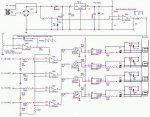I'm looking at a project where about 25 lighting loads are controlled by supplying 0 to 5 VDC to their dimmable load controllers. Zero volts to the load controller and the lights are off and 5 volts results in full brightness. The original control system was hit by lightning and was overkill in the first place. Currently they are flipping breakers to have full brightness lighting.
I'm thinking of around 5 pots in the big room being read via ADC by one PICAXE then those values being transmitted serially to a second PICAXE in the electrical closet where the load controllers are located. A multiconductor (5?) cable is in place between the two locations for the original system. Since isolation of the PICAXE system from the load controllers is a good idea I'm thinking PWM out to a LED based opto device/circuit would one way of accomplishing the goal of 0 to 5 VDC to the controllers. Not sure of the current requirements but I would guess it isn't over 1A per load controller.
Does anyone have experience with this sort of thing and/or what are your thoughts on the best way to go about this?
I'm thinking of around 5 pots in the big room being read via ADC by one PICAXE then those values being transmitted serially to a second PICAXE in the electrical closet where the load controllers are located. A multiconductor (5?) cable is in place between the two locations for the original system. Since isolation of the PICAXE system from the load controllers is a good idea I'm thinking PWM out to a LED based opto device/circuit would one way of accomplishing the goal of 0 to 5 VDC to the controllers. Not sure of the current requirements but I would guess it isn't over 1A per load controller.
Does anyone have experience with this sort of thing and/or what are your thoughts on the best way to go about this?



